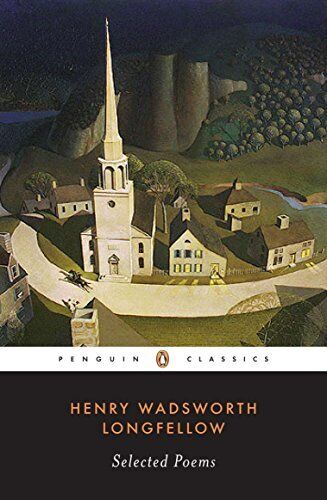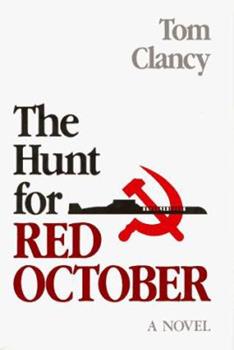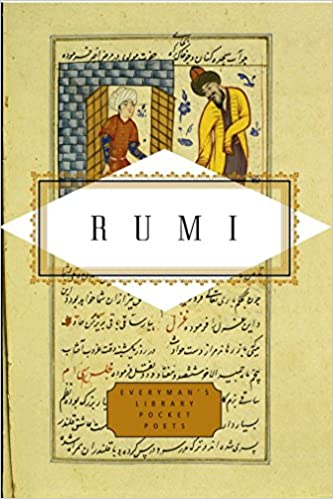Jane Eyre has been hailed by many as a tale of romance, passionate love, and forward-thinking feminism. Charlotte Bronte’s young and plain heroine learns how to navigate the world with quiet calmness and deliberate, well-thought-out actions. Bronte’s writing style is endearing. She tells Jane’s story in the first-person view so it’s almost like a letter from Jane to the reader to tell her story with no apologies.
There, that was my fluffy introduction. Now I confess: I do not like Jane Eyre. That was the first thing I thought when I finished reading it as a teenager, and that’s still how I feel today, having just finished the audiobook as an adult. Why? I usually love a good romance. I always love a good storyline. And I definitely love the old English literary style. So why do I love to hate Jane Eyre?
Spoiler alert! Before I continue, I must warn you that I will be spoiling the story if you haven’t read the book before. I can’t tell you why I dislike the book without giving it away. Sorry. So, I put these pictures here as a barrier between my introduction and the rest of my post. These are my two lovely copies of Jane Eyre to distract you.
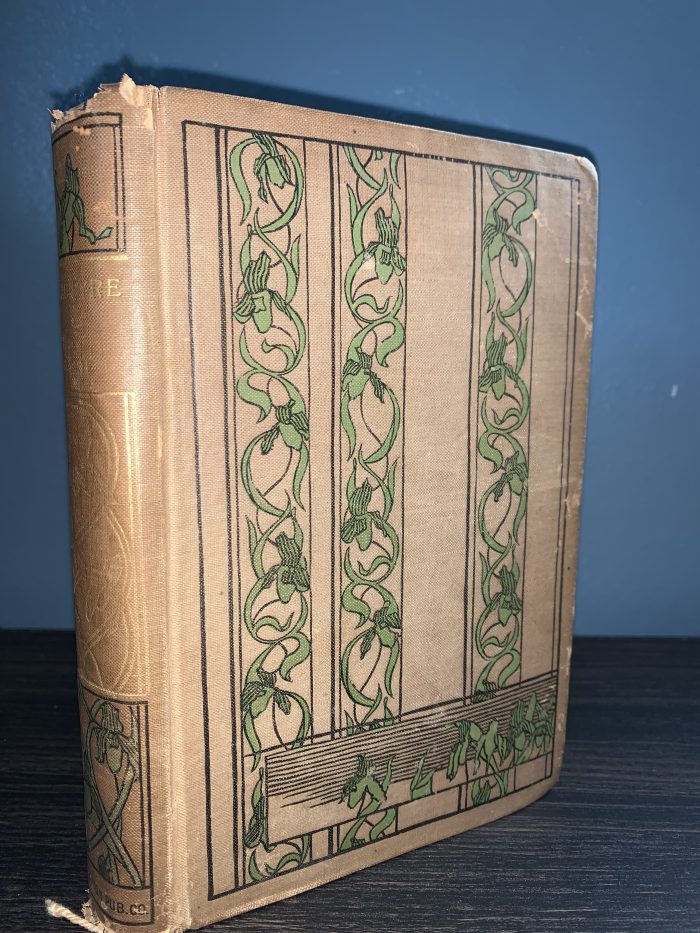
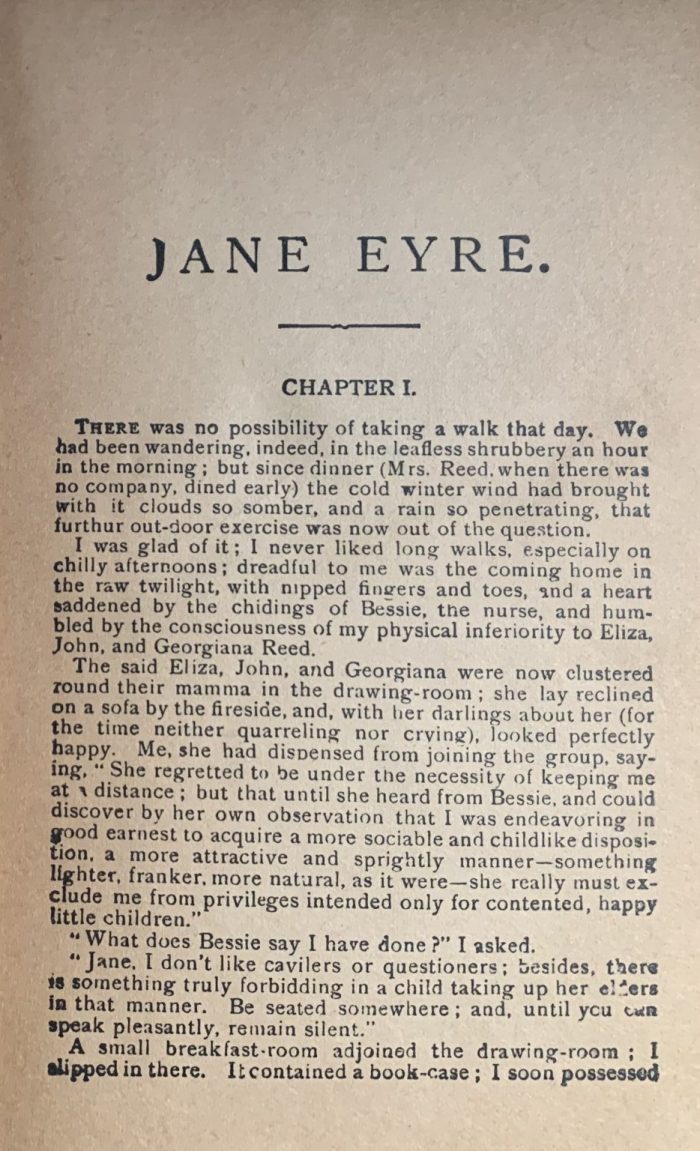
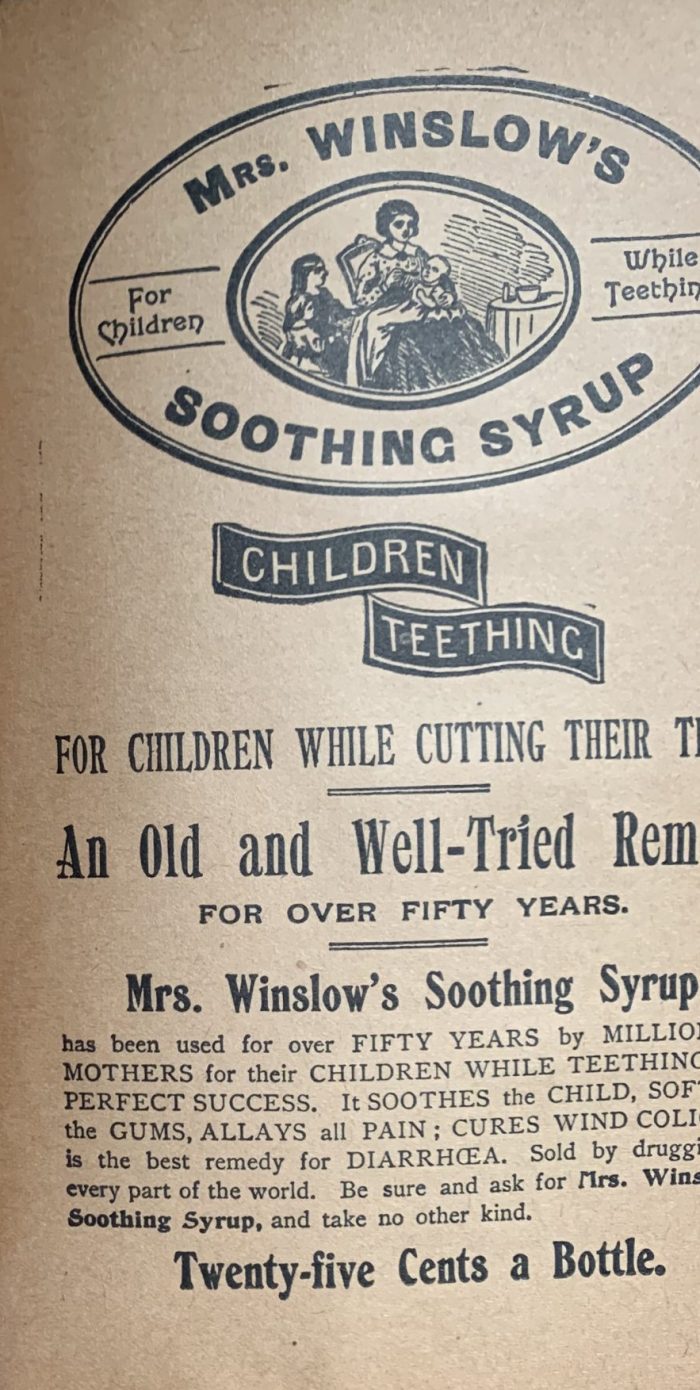
This volume with green vines and gold lettering doesn’t have a copyright date, but there is an inscription:
“From Grandma Christmas 1897”
The last page of the book is an advertisement for Mrs Winslow’s Soothing Syrup.
It’s hard to read the inscription, and I can’t make out the name.
The stamp next to the inscription reads
“D. L. Juergen’s,
Drugs and Medicines
News Dealer and Book Seller
Complete Line of Musical Instruments
Sutton West VA”
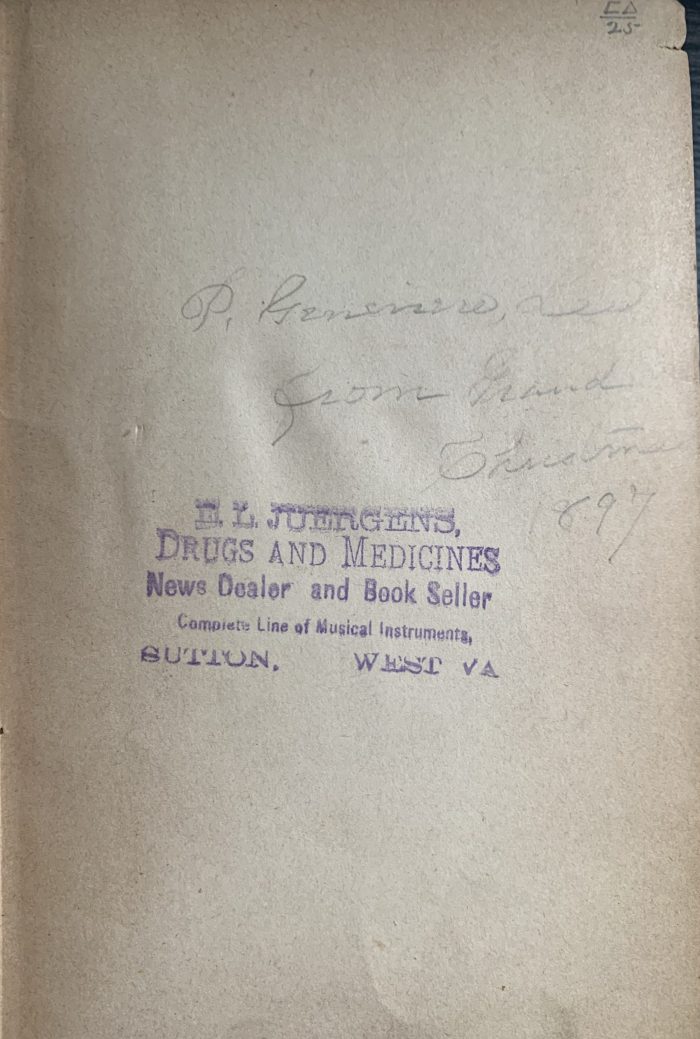
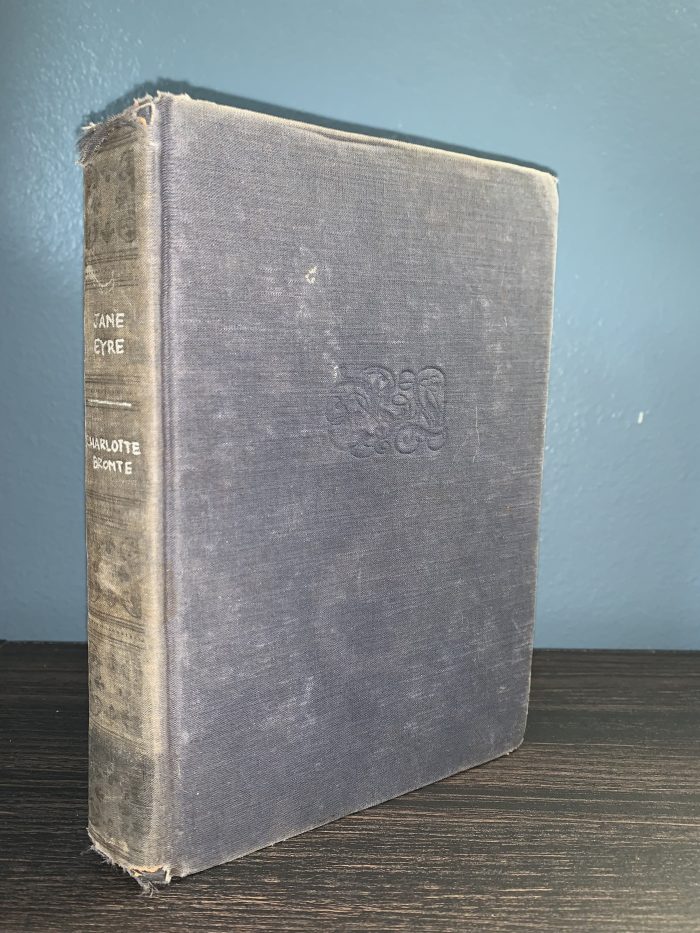
My plain blue volume has a decorative stamp on the front cover. This was the first copy I bought. It’s an old library copy with permanent marker lines on the title page and a discard stamp inside. There is no copyright date. This volume is in better shape than the gold and green one. The pages are not so brittle. It’s roughly bound, by which I mean that the edges of the pages are uneven on the outer side. This is the book I carried with me when I dressed as Belle for Halloween because it just looks so neat.
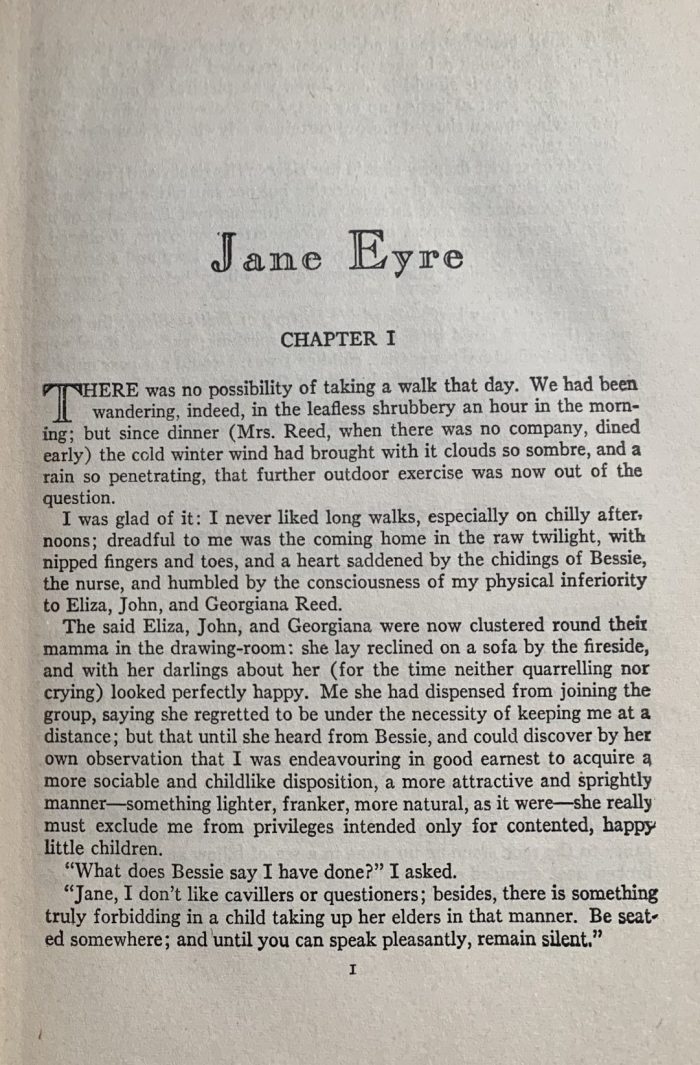
It’s kind of sad to see the marks in this volume, but then I think of how many people got a chance to enjoy this very book before I found it, and that’s nice to think about.

Now you may turn back. Go find a copy of your own to read, and return when you’ve finished to see if you agree with me. If you proceed, you’ve been warned. I am about to spoil the book for you.
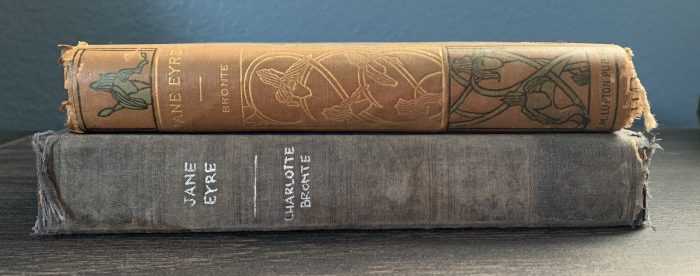
As a brief refresher on the story, yes, this is the one with the crazy wife in the attic.
First, the part of Jane Eyre that I love: the style of writing. Bronte is vivid in her descriptions. Her characters are believable; they could be real people. It’s easy to picture each of the story’s settings – the countryside or the house or the gardens. Lovely! The usage of the English language is so beautiful I find myself wanting to write or speak in the same manner.
Who are the major characters in Jane’s story?
- Jane Eyre is described as youthful but plain. She is a deep thinker but doesn’t usually voice her opinion, having been taught early in life that her opinion was odious to those around her. She is religious and moral. Her belief in God dictates many of her decisions throughout the book.
- Edward Rochester is twenty years older than Jane. He’s not handsome, has a temper, and – as we learn later – is full of deception. He professes his love for Jane in ardent, passionate, almost poetic words.
- The Reid family consists of Aunt Reid and cousins John, Eliza, and Georgiana. Jane became the ward of the Reids when her parents died. Aunt Reid dislikes the child but promised her dying husband to care for her. Aunt Reid kept secret the fact Jane had a living uncle on her father’s side ’til Jane was grown and caring for the aunt on her deathbed.
- Mr. Brocklehurst is the master of the school Jane is sent to as a child. He is harsh and hypocritical, and his actions lead to the deaths of half the students from typhus fever before the school is reformed.
- Diana, Mary, and St John Rivers are siblings who take Jane in and nurse her back to health after she spends several days without food, shelter, or money. Eventually they discover they are Jane’s cousins on her father’s side. Jane receives an inheritance from their mutual uncle which she splits between the four of them. When they try to protest, Jane ensures them she is happier to have family who love her than money.
- It’s important to tell you that St John’s desire is to be a missionary to India, and he tries to pressure Jane into marrying him, not because he loves her, but because he sees she is a hard worker who would benefit his ministry in India. Jane refuses his proposal because she knows he does not love her.
- Helen is Jane’s friend in school who dies of consumption. She is the earliest example to Jane of piety and long-suffering.
- Adele is Jane’s pupil in Mr Rochester’s house. She is the child of a French opera dancer.
Now, without further ado, the story of Jane Eyre through my eyes.
After a childhood devoid of love, the orphaned Jane is sent to Lowood School for girls. After she graduates, she teaches there for two years before becoming governess to a little French girl named Adele, the ward of the wealthy Mr Rochester.
Jane is young, barely twenty. Mr Rochester is almost forty. Jane is innocent; Mr Rochester has lived a life of pleasure in Europe. They begin to have daily conversations on deep subjects. Mr Rochester tells Jane of his life, his faults, his passions, his former lovers. Adele, he says, may or may not be his own child. Jane tells Mr Rochester of her lonely upbringing. He notices her piety and her goodness, the very opposite of himself.
Mr Rochester is, in my opinion, a rogue (rogue meaning dishonest and unprincipled). He plays with Jane’s feelings and tries to get her to see the world as he does, as though he is trying to corrupt her without corrupting her. What do I mean? He wants her to remain innocent, sweet, pure, pious, but he also wants her to feel jealousy, anger, discomfort. He draws out her human emotions which she had hidden behind her plain grey dresses and dutiful spirit.
Here is an example of how Mr Rochester plays with Jane’s emotions: After sone time, Jane begins to fall in love with Mr Rochester. Hers is the simple love that grows from a heart that has never felt love before. She reproaches herself, and she keeps telling herself she is only the governess. Mr Rochester couldn’t possibly feel for her as she feels for him. So, she tries to hide her feelings for him.
All the while, Mr Rochester knows exactly what he is doing as he draws Jane out of her shell. First breaking the shell of shyness, then tempting her with a private walk here and a personal conversation there. Glimpses, grins, and even subtle touches like a handshake or brush of his hand against hers. He draws her in.
Then he invites a group of neighbors to stay at his estate. Jane watches as Mr Rochester begins to give another lady – a high-born lady – tender glances and smiles. Poor Jane. She reproaches herself the more, believing he never could have felt anything for her. Again, she tells herself she is just the governess. The group stays at the house long enough for a rumor to begin that Mr Rochester intends to marry the lady.
During the group’s stay, Jane is called away to tend to her dying Aunt Reed. Before she goes, she asks Mr Rochester to find her a new position because she can’t stay at the house once he is married to the other lady. When Jane returns, Mr Rochester takes her on a walk through the garden. They begin discussing the new position he found for her in Ireland, and Jane’s calm resolve breaks. She speaks to him passionately, telling him that she cannot bear to leave because then she would never see him again, but she knows she cannot stay because his bride does not like her. This is when Mr Rochester tells Jane that he only ever loved her, and he didn’t care one whit for the other woman. He confesses that he brought her to the house to incite Jane to jealousy – he wanted to know if she truly, passionately loved him. He asks her to marry him.
Many people point to this scene as one of the most romantic, passionate scenes in the book. Indeed, Mr Rochester’s words are lovely.
“I offer you my hand, my heart, and a share of all my possessions… I ask you to pass through life at my side – to be my second self, and best earthly companion.”
Mr Rochester’s First proposal to Jane
The story thus far has been a wonderful tale of triumph over obstacles, courage for the next step, and the reward of passionate love at the end. But here the story takes a dark turn. Jane’s and Mr Rochester’s characters are tried by fire (figuratively and literally)and are shown to be what they truly are.
Mr Rochester is passionate, lustful, and he is hiding a secret that could destroy everything he thinks he loves. A secret which he is willing to keep from Jane, even though it would degrade her not only in the sight of men but in the sight of God. (I have mentioned that Jane was pious. She was God-fearing and extremely moral, steering clear of what she believed would stain her good name.)
Mr Rochester insists on lavishing Jane with gifts. New clothes, a dainty wedding trousseau, and promises of a grand honeymoon on the European continent. He wants to marry Jane within the month. She has no family to stand in the way, no former lovers to turn up and object. She is alone in the world except for him. And so – rush! rush! rush! – Mr Rochester rushes Jane to the alter. Even on the day of the wedding, he calls to her impatiently while she is getting ready. He not-so-gently leads her to the church and presses the minister to hurry up with his sermonizing and long talking so they can finally be wed. But just before Jane and Mr Rochester take their vows, two men interrupt the wedding.
“An insuperable impediment to this marriage exists… Mr Rochest has a wife now living… The record of the marriage will be found in the register of that church: a copy of it is now in my possession.”
Mr Briggs on what hinders Mr Rochester marrying Jane
Mr Rochester’s passionate love changes to rage and even hatred. He charges out of the church, pulling his almost-bride behind him. The minister and other men follow them up the stairs of the home to a locked room Jane didn’t know existed. There they find a woman grunting like a dog, unkempt and insane. She rushes to Mr Rochester with the intent of strangling him. After a struggle, he subdues her, turns to the small company, and states, “That is my wife“. He points out the differences between the insane woman and Jane – the demon and the young girl.
“Bigamy is an ugly word! I meant, however, to be a bigamist; but fate has out-maneuvered me, or Providence has checked me – perhaps the last.”
Mr Rochester when his first marriage is revealed
Jane’s heart is broken. The minister declares she is cleared from any blame; it is Mr Rochester who is at fault. Mr Rochester – who spent months of playing at Jane’s emotions – knew all along he could not lawfully take Jane as his wife. Mr Rochester, already married, yet still proposing to Jane. He called it passionate love. I call it lust. He wanted what he knew he should not have. And he’d had it on the continent with other women. Poor Jane, who had never been the attention of any boy – much less a man. Jane, who was tender, who was new to the world of love and passion and jealousy and loss. And so, at this moment, I knew I hated Mr Rochester.
Jane leaves Mr Rochester’s home. She is penniless, and in her haste, she leaves all her belongings in a carriage. After several days without food or shelter, she is taken in by three siblings: Diana, Mary, and St John Rivers. They become good friends. Then they find out that they are related on her father’s side. As I mentioned earlier, Jane is so happy to have family who love her and whom she loves that she happily splits her inheritance between the four of them. She would rather have family than money.
Try as she will, Jane cannot forget Mr Rochester and her love for him. Jane steps outside one night and hears Mr Rochester’s voice clear as though he were standing beside her. “Jane! Jane! Jane!” She decides in that moment to return to Mr Rochester, and so she answers, “I am coming!” She doesn’t even know to what she is returning, only that she is going to him whom she loves.
When Jane returns to Mr Rochester’s home, she finds it a burned-out ruin. She gets the story from the villagers: the insane wife broke loose from the upstairs prison and set fire to the home. Mr Rochester made sure everyone made it out safely, then he went to his wife who was standing on the roof. He tried to save her, but she jumped to her death. As he descended the stairs through the flames, they crumbled, injuring him terribly. Mr Rochester was now blind with only one good hand. And this is how Jane finds him, living with his former servants.
The first time Jane speaks to Mr Rochester, he believes she is a phantom. She stands before him, holds his hand, and convinces him she is real. That day and the next, Jane tells him where she’s been, of her new-found family, and even of St John’s proposal. She stirs Mr Rochester to jealousy, as he had done to her before. He bids her leave to return to St John, but she assures Mr Rochester that she intends to stay with him, as “neighbor, nurse, housekeeper, or companion” if he wishes.
“Ah! Jane. But I want a wife.”
Mr Rochester’s Second proposal to Jane
Their bond is renewed; their love grows deeper. And here, I will let go some of my hatred of Mr Rochester. By the end of the book, he has repented of being a rogue to Jane. He changed when Jane left him. He knew he was in the wrong all along, but I think he took for granted that Jane would ever see the situation from his point of view. He hoped that – even with the knowledge of the insane wife – Jane would be willing to be his mistress. She wouldn’t. She wouldn’t even let him kiss her once she knew of his first marriage. In the light of Jane’s goodness, Mr Rochester became the great transgressor.
I believe Mr Rochester eventually came to terms with the marriage he despised. And though he didn’t try to love his insane wife any more after Jane left, he did try to save her life, even putting his own life in peril. He was humbled by the fire and his injuries. So, when Jane returned to him, he could no longer offer her anything but himself as he was – blind with one hand. And much to his surprise, Jane heartily accepts him.
“I love you better now, when I can really be useful to you, than I did in your state of proud independence, when you disdained every part but that of the giver and protector.”
Jane Eyre
Jane does eventually get the happily ever after she desired. I am happy for her. And while I still dislike the rogue Mr Rochester began to be, I’m also glad he does in the end get to give Jane what she desired most: his passionate love for her.
And that, my friends, is Jane Eyre – the classic that I love to hate.
